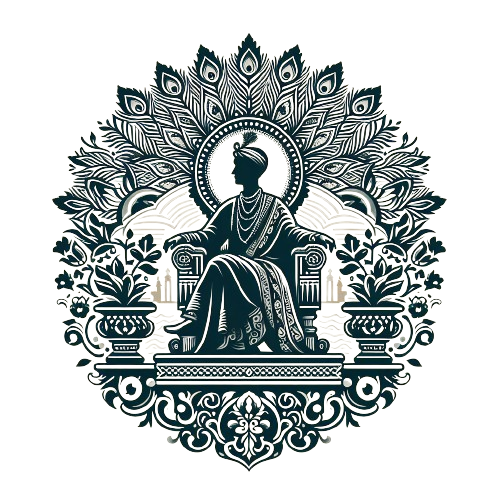Throughout history, Bahadur Shah 1 became a famous Mughal Emperor of India. Evidence of his life can be found in history books and numerous oral and written sources. This period was marked by the intertwining of cultural and administrative reforms, religious tolerance guided by his wise leadership, which transformed the political scene in the Indian subcontinent in many ways. Here, we discuss the life, the times of prosperity, and the impact on Mughal history of Bahadur Shah 1 against the backdrop of his remarkable reign.
A Remarkable Journey of a Powerful Ruler: Shah Alam-I (Bahadur Shah 1)
- Birth and Lineage: On October 14, 1643, the first son of Aurangzeb and Dilras Banu, named Mu’azzam, was born in Burhanpur. He inherited a Mughal throne that promised not only rewards and a crown but also the burden of glorious and onerous responsibilities.
- Education and Training: Bahadur Shah 1 received a comprehensive education encompassing knowledge of languages, literature, and military operations, among others. His upbringing prepared him for governance, which was instrumental in gaining the people’s confidence and shaping his high moral principles.
Ascension to the Throne
- Succession Disputes: In 1707, when Aurangzeb passed away, a succession crisis arose. His brothers fiercely contested the throne. Bahadur Shah 1 faced criticism but eventually emerged victorious, culminating in a bloody scenario marred by political maneuvering.
Kon Wali Bana (Roshan Ara), Seventh Mughal Emperor
- Policies and Governance: Bahadur Shah 1 held the reins of the empire throughout his reign and implemented administrative reforms and fostered a sense of democracy. He enacted reforms like devolving authority and promoting prosperity for all agriculturalists.
- Military Campaigns: While Bahadur Shah’s military campaigns were less frequent compared to previous emperors, he wasn’t spared rebellions from regional powers and disloyal governors. His strategic mind often prevented conflict and preserved the empire during perilous times.
Cultural and Architectural Contributions
- Patronage of Arts: As an outstanding art lover, Bahadur Shah 1 was recognized for creating a flourishing cultural atmosphere within the Mughal dynasty. He associated with poets, artists, and musicians. Through his support, he ushered in a golden age of Mughal literature and music.
- Architectural Legacy: Though his reign was brief, this leader provided lasting architectural inspiration. Thanks to his patronage, mosques, palaces, and mausoleums were built, their design a testament to the splendor and artistry of Mughal construction.
Religious Policies and Tolerance
- Interfaith Relations: Bahadur Shah’s reign was marked by a spirit of religious tolerance and an open-door policy. He fostered amicable relationships with leaders of different religions, ensuring social cohesion and the recognition of each community.
- Treatment of Non-Muslims: Unlike some of his predecessors, Bahadur Shah 1 believed in and practiced a secular policy that was tolerant of non-Muslims. He appointed them to high positions within the imperial administration and valued their insights on building a prosperous empire.
Personal Life and Legacy
- Family Dynamics: A crucial aspect of Bahadur Shah’s life was his strong and unbroken family. He nurtured a close circle within the royal court, and the Mughal dynasty’s legacy continued through his next generation.
- End of Reign: Bahadur Shah’s reign ended with his death on February 27, 1712. His departure marked the beginning of the decline of the Mughal dynasty, yet he left behind many pristine symbols of cultural diversity and peaceful coexistence.
Impact on Indian History
- Assessment of Bahadur Shah’s Rule: Historians appraise Bahadur Shah’s rule based on three key features: good governance, cultural patronage, and religious tolerance. Under him, a period of relative peace and prosperity followed the decline that had begun earlier. He thus left an influential mark on Indian history.
- Long-term Consequences: The chronicles of Bahadur Shah’s regime continue to be significant even today, reflecting in the rule of later kings and influencing the socio-cultural fabric of the entire subcontinent. His work on promoting equality within diversity and supporting the culture of different nations and peoples formed a foundation for a multicultural society in India.
Conclusion
Bahadur Shah 1, also known as Shah Alam-I, was a key figure who led the Mughal state during the beginning of its decline. During his reign, a cultural revival and a period of religious tolerance took place. Through his dedication to government reforms and efficient administration, he created an atmosphere conducive to the empire’s development and success during a period of transition and turmoil. Bahadur Shah’s legacy continues to be relevant today, serving as a reminder of the rich and complex layers of Indian culture and tradition.
FAQs
- Do we know what his actual name was?
- Bahadur Shah’s real name was Mirza Muhammad Mu’azzam.
- Who was the one who took the throne and became King Bahadur Shah 1?
- Bahadur Shah 1 ascended to the throne of the Mughal Empire after defeating his brothers in a war of succession following his father Aurangzeb’s death.
- A question that would be worth looking into is how did Bahadur Shah’s cultural contributions impact the Mughal era?
- Bahadur Shah 1 actively supported artists, poets, and musicians, fostering a flourishing cultural environment within the Mughal dynasty. His patronage ushered in a golden age for Mughal literature and music.
- How did Bahadur Shah promote the idea of religious tolerance in India?
- Bahadur Shah championed religious tolerance through an open-door policy and fostering harmonious relationships with leaders of various faiths. This ensured social cohesion and respect for all communities, regardless of their religious beliefs.
- What is the historical evaluation of Bahadur Shah’s reign?
- Historians acknowledge Bahadur Shah’s contributions through his focus on:
- Reform-oriented administration: He implemented reforms to improve governance.
- Cultural patronage: His support for the arts led to a cultural revival.
- Religious tolerance: He promoted a policy of religious tolerance, fostering peaceful coexistence.

